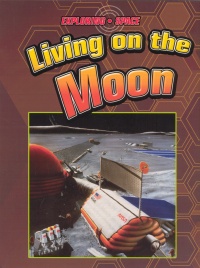| ________________
CM . . .
. Volume XVI Number 35. . . .May 14, 2010 
 |
Living on the Moon. (Exploring Space).
David Baker & Heather Kissock.
New York, NY: Weigl (Distributed in Canada by Saunders Book Co.), 2010.
32 pp., pbk. & hc., $10.95 (pbk.), $22.95 (hc.).
ISBN 978-1-60596-022-7 (pbk.), ISBN 978-1-60596-021-0 (hc.).
Subject Headings:
Moon-Juvenile literature.
Moon-Exploration-Juvenile literature.
Grades 3-6 / Ages 8-11.
Review by Margaret Snow.
***1/2 /4
|
| |
|

excerpt:
MOON BASE BASICS
NASA plans to develop the Moon base over several years. At first, it will be small, supporting only a few scientists at a time. Still, it will have all the materials the scientists need to live and work on the Moon
1. HABITATION
Scientists will live in this part of the base. It will contain sleeping quarters, showers, and a kitchen.
2. PRESSURIZED ROVER
The rover will allow scientists to travel on the Moon in a pressurized environment. This will allow them to stay away from the base for several days and perform more in-depth studies.
3. POWER STORAGE UNITS
The power storage units will collect the energy coming from solar rays and store it for use on the base. They will help provide electricity and ventilation inside the base.
4. SURFACE MOBILITY CARRIER
Like the pressurized rover, this vehicle will allow scientist to travel on the Moon. Unlike the pressurized rover, the surface mobility carrier will not be pressurized. This means that it will only be used for short trips and astronauts will have to wear spacesuits and oxygen packs when travelling in it.
With the first encounter one has with the book, Living on the Moon, one realizes not only how far we have come, but also how far we have to go. Living on the Moon is full of historic and breathtaking colour photographs as well as digitally enhanced images that show the many pieces of the Moon exploration, study and colonization puzzle fitting together.
This is David Baker and Heather Kissock's second time working as a writing team in the "Exploring Space" series. David and Heather have done an excellent job of reaching their target audience to explain the technologies man has developed and will be utilizing to explore the moon. This colourful work contains a wealth of information. Students will like the fast paced move from topic to topic which enhances the book's flow. One can foresee a class begging for extra computer time to investigate the Moon more thoroughly through the use of the recommended websites.
English author David Baker had worked with NASA 12 years before becoming an aerospace consultant. He currently has more than 60 books in publication. Heather Kissock has 17 years in the book industry working at jobs ranging from sales to editor, and she currently specializes in writing nonfiction children's books.
The book delves into the history and accomplishments in the Moon Race, the projected revitalization of the Return to the Moon projected for 2010, the basic design needs for lunar travel both going, once there and returning, construction and design of the Moon Station, power generation and food production on the Moon, educational requirements for those interested in a career, typical schedule for a Moon work day, and an outline of who the new players will be in the
Space Race Game.
Favourite text features are interspersed throughout the pages and are colour coded for effect. These include the yellow TEXT BOXES explaining each picture, the white GET CONNECTED boxes with fascinating website recommendations, the BRAIN BOOSTER boxes done in shocking pink helping to keep focus on some pretty outstanding facts and the golden THINK ABOUT IT boxes posing open-ended questions to the reader. All this and it also has the basics: a Table of Contents and clearly labelled diagrams. As well, the book is incredibly well scripted and gives the information without overwhelming the reader with overly technical vocabulary. The book finishes up with several bonuses, like a page dedicated to the GOOGLE Space Contest, a Test your Knowledge with 10 questions from the text (answers are found upside down on the same page for ease with self evaluation), Further Resources for recommended reading, Website list, Glossary of 25 bolded terms, plus a concluding index.
The book is excellent, but I do have one small reservation. On page 4, the proofreaders missed an error when editing:
"With the help of NASA, scientists began [sic] make plans for a lunar research station, or Moon base."
This book may just spark one's interest enough to check out the other books in the "Exploring Space" series, which also includes International Space Station, Journey to Mars, Living in Space, Probing Space, Rockets, Satelites and The Space Shuttle. It is a true find to discover books that meet their target audience to explain the technologies man has and will be utilizing to explore the universe.
With that being said, due to the quality of writing, the attention grabbing photography, the caliber of computer reference sites, being filled with facts, the readability and the ease that teachers will be about to use the text features to further enhance student comprehension, I recommend this book. It would make an excellent addition to school libraries in facilitating high functioning primary and all junior students in creating projects, as well as for its value of being great nonfiction, high interest reading.
Highly Recommended.
Margaret Snow is a teacher-librarian, computer and media literacy teacher in a small, rural school in Southwestern Ontario.

To comment
on this title or this review, send mail to cm@umanitoba.ca.
Copyright © the Manitoba Library Association. Reproduction for personal
use is permitted only if this copyright notice is maintained. Any
other reproduction is prohibited without permission.
NEXT REVIEW |
TABLE OF CONTENTS FOR THIS ISSUE
- May 14, 2010.
AUTHORS |
TITLES |
MEDIA REVIEWS |
PROFILES |
BACK ISSUES |
SEARCH |
CMARCHIVE |
HOME |
